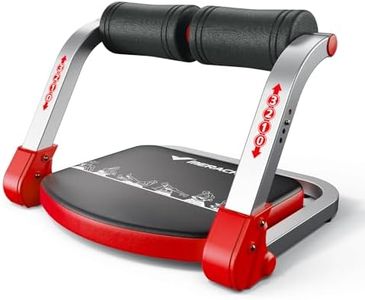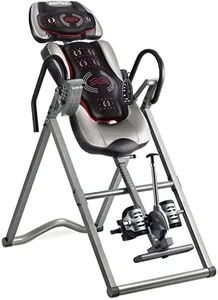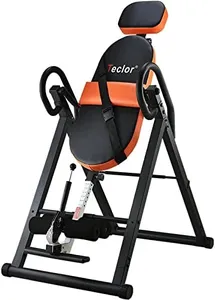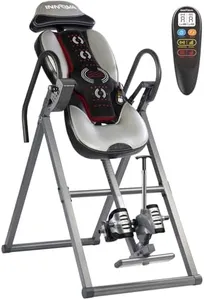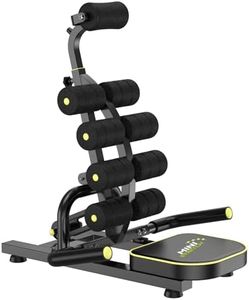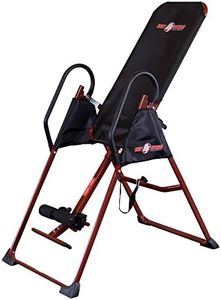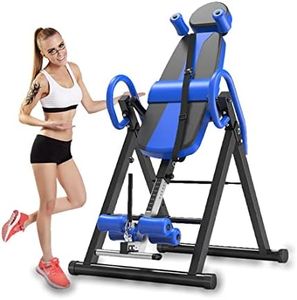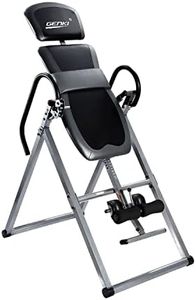We Use CookiesWe use cookies to enhance the security, performance,
functionality and for analytical and promotional activities. By continuing to browse this site you
are agreeing to our privacy policy
10 Best Inversion Tables
From leading brands and best sellers available on the web.Buying Guide for the Best Inversion Tables
Inversion tables are popular tools designed to help relieve back pain, improve flexibility, and support overall spinal health by allowing you to hang upside down or at inclined angles. Choosing the right inversion table depends on your comfort, safety needs, and physical goals. To make the best choice, you’ll want to focus on the build quality, comfort features, safety mechanisms, adjustability, and ease of use. Understanding the key specs for inversion tables will help you find one that matches your body type and your intended use.Weight CapacityWeight capacity refers to the maximum user weight the table can safely support. This is essential for safety—using a table that cannot accommodate your weight can be dangerous and may void the warranty. Inversion tables typically range from around 220 lbs up to 350 lbs or more. If your weight is near the upper end of the limit, consider picking a model with a higher capacity for better durability and stability. Always choose an inversion table with a weight limit comfortably above your own weight to ensure both safety and longevity.
Height RangeThe height range specifies the span of user heights the table can accommodate. This is important because using a table that matches your height will ensure proper balance and control during inversion. Most inversion tables adjust to fit users from about 4'10" to 6'6", but variations exist. Make sure the table can be adjusted to your height so that you can easily rotate and return upright without strain. Accurate adjustment contributes to better user experience and safer operation.
Angle AdjustmentAngle adjustment refers to how far the table can tilt and how easily you can set or lock it at certain inversion angles. Some tables offer preset angle stops (like 15°, 30°, 60°, or full 90°), while others allow you to set any angle within the range. If you're new to inversion, starting with smaller angles can help your body adapt, so flexibility in angle settings is valuable. Choose a table with angle adjustment options that correspond to your comfort level and desired progression.
Ankle Support SystemAnkle support is how the table holds your feet and ankles in place during inversion. Comfort and security here are crucial because your ankles bear most of your body weight when inverted. Some tables have simple foam rollers, while others use padded locking mechanisms for extra comfort and safety. If you have sensitive ankles or want to invert frequently or for longer periods, look for more ergonomic and padded supports to prevent discomfort.
Frame ConstructionFrame construction describes the material and build quality of the inversion table, which directly impacts durability, strength, and stability. Most tables use steel frames, but the thickness and design can vary. Heavier and sturdier frames increase stability, which is important for heavier users or those wanting to invert fully. On the other hand, lighter frames are easier to move and store but may be less stable. Assess your need for portability versus stability to find your best fit.
Folding and StorageFolding and storage refer to whether and how easily the table can be collapsed for storage when not in use. If you have limited space at home, a model that folds flat or to a compact size will be easier to manage. However, tables that fold up may be slightly less robust than non-folding types. Choose based on your available storage area and how often you plan to take the table out and put it away.
Padding and Comfort FeaturesPadding includes the cushioning on the backrest and sometimes the ankle area. More padding usually translates to a more comfortable experience, especially for longer sessions or for people with sensitive backs. Consider your own comfort preferences and any sensitivity when choosing the amount and type of padding you need for the backrest and supports.
Safety FeaturesSafety features cover elements like safety locks, non-slip feet, sturdy handrails, and secure ankle cuffs. These are crucial for preventing falls, slipping, or sudden movement while using the table. If you’re new to inversion or plan to invert alone, prioritizing models with robust safety features can give you peace of mind and a safer overall experience.
